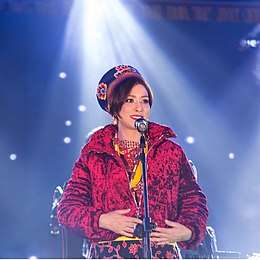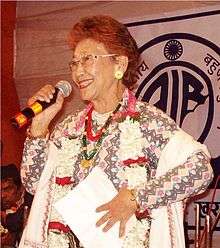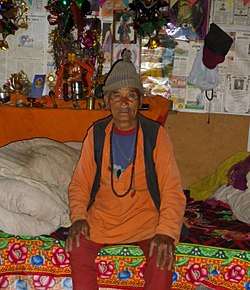Tamang people
| Total population | |
|---|---|
|
1,539,830 | |
| Languages | |
| Tamang language | |
| Religion | |
|
90% 10% other (including |
The Tamang ཏ་མང (Devnagari: तामाङ; tāmāng) are the largest Tibeto-Burman ethnic group within Nepal and traditionally Buddhist by religion. Constituting 5.6% of the national population at over 1.3 million in 2001, increasing to 1,539,830 as of 2011 census,[1] yet contested.[2] Tamangs are also a significant majority in Sikkim and Darjeeling District of West Bengal, India as permanent settlers;[3][4] their languages are the fifth most spoken in Nepal (note all Tamang languages are not mutually intelligible). They are one of the Tibetan migrant who come to Nepal.[5] Peculiar to Tamang people are complex marriage restrictions within the community.
Status
In Nepal, until 1950, Tamangs were neither accepted into government posts, whether administrative, judicial or political, nor allowed to accept foreign employment, serving as a labour pool for the ruling class.[3] But nowadays, Tamangs are highly respected as Buddhist Monks (priest) as rinpoche, khempo. In many Tamang Villages, there is still a tradition of sending the second son to study Buddhism and preferably to remain in the Monastery, and serve as a Buddhist Monk throughout his life.
The Nepal Government has considered that the empowerment of Tamang community is essential to in order to increase the living standard of the people. On August 3 the Nepalese parliament adopted a bill amending the Civil Service Act 1993. The amendments provide reservations for disadvantaged groups by allocating 45 percent of the jobs in the bureaucracy to these groups.
Today they inhabit the borders of Nepal and Tibet, due to marginalization from Kathmandu, and are among the groups hardest hit by the April 2015 Nepal earthquake.
Political participation
Tamangs are represented by Tamsaling Rastriya Mukti Morcha and Tamsaling Nepal Rastriya Dal, neither of which holds any seats in Parliament. The umbrella group Mongol National Organisation supports self-determination and works against said discrimination not just for Tamangs but for all Mongoloid groups in Nepal. Mongol National is against conversion to Hinduism of non-Hindus, but it holds no official parliamentary vote. Federal Limbuwan State Council (FLSC) also works towards similar goals for self-determination for the Kirati peoples, who co-mingle with Tamangs, citing a reneged treaty with Kathmandu for autonomy.[7] The associated Sanghiya Limbuwan Party has participated in calling banda during the 2015 Nepal blockade,[8] nevertheless international press had not only failed to take note of their bandh, but even pretended not to notice their very existence and instead focused intently on 4 party India-backed Madhesi Morcha actions, geopolitical concerns with China, as Limbuwan also opposes both the Madhesi goals as well as Kathmandu's domination.[9] However, there is rationale to India and Western nation's denial of information about Limbuwan actions during the fuel blockade, in the 1980s, a violent Gorkhaland movement within India was led by the prominent Tamang Subhas Ghising to which India had viewed as a security threat due to the proximity of India's chicken neck.[4] Madan Tamang, a Tamang-Indian politician, and proponent for Gorkhaland statehood, was assassinated in 2010, with West Bengal government placing blame on another Gorkhaland political party, in effect weakening the movement. Gorkhaland Territorial Administration was then created in place of statehood in India, nevertheless across the border, ethnic discrimination issues regarding the numerous Mongoloid groups (who have taken part in each other's politics) are left unresolved within Nepal. In 2017 Binay Tamang was appointed as the Chairperson of GTA.[10]
Religion
.jpg)
The religion is considered by Tamangs as Nyingma tradition of Vajrayana Buddhism, the earliest form of Buddhism to come to Nepal/Tibet with Padmasambhava, and due to geopolitical focus on Tibet, Tamangs hold their beliefs are also largely ignored by Western scholars.[3] Tamang have gompas (monasteries) in every sizeable village. Every family has their special Buddhist Yidam and book to practice every morning. The Tamangs retain jhankris (shamans) in addition to their Lama clan (Tamang) (priests), the latter whose surnames are also Lama. Additionally there exists the honorific term Lama (honorific), assigned to all Tamang regardless of kinship clan (swagen bhai). This is not to be confused with Lama of Tibet or the Sherpa Lama surname and clan. These jhankris perform certain rites such as trances and sacrifices to alleviate problems or assure good fortune.[3]
Etymology
Tamang was derived from the word Tamag, where Ta means “horse”, and Mag means “soldier”.[11]
Culture
Festivals
Sonam Lhochhar is the main festival of the Tamangs and is celebrated in the month on Magh (February - March).[12] It is celebrated to welcome the Tamang new year.
Colorful flags, printed Buddhist mantra cloths are put up in various places in villages and towns.[1] The Tamangs have a genre of music called called " Tamang Selo" that is performed with the Damplu instrument, also known as Damphoo Dance, having a brisk movement and rhythmic beat specific to the Tamangs.[4]
The second most important festival is Saga Dawa (Buddha Jayanti) and is celebrated as a religious festival.[13]
Dashain and Tihar (festival) is also celebrated with much enthusiasm by Tamangs.[1]
Livelihood
Most Tamangs are farmers, engaged in agriculture. Due to the lack of irrigation at higher altitudes, their crops are often limited to corn, millet, wheat, barley, and potatoes. They often supplement their farming income with manual labour. Due to the discrimination experienced by the Tamang people in the past, they have remained on the whole poorly educated, and the majority have been limited to working as farmers, mountain trekking, portering, and driving in Kathmandu. They also work in manufacture of Tibetan rugs, Thankas (Tibetan painting), driving and labour.[3] As far as farming is concerned, Tamang are dependent on rainfall and do not employ modern machinery.[1]
Music


Tamangs are known in Nepali Art/Music of Nepal. Some prominent names are: singer- Hira Devi Waiba,[14]singer- Kunti Moktan,[15] Navneet Aditya Waiba, Phiroj Shyangden, Prashant Tamang,[16]Zenisha Moktan,[17]Nima Rumba,[18]Aruna Lama,[19]Karma Yonzon, Gopal Yonjan[20], Prem Lopchan.
Kinship clans
Thars (Tamang language:Swagen Bhai) are exogamous clans with complex intermarriage restrictions. There are over 39 listed swagen bhai in one study.[1]
Origins and history
Tamangs are coming from tibet and have long inhabited Kathmandu Valley and the hills of Nepal in general, yet the origins of Tamang are exactly from upper tibet( around govi desert ) according to archiological study done by Dr. anatoly yakoblave shetenko, yet they believe they are indigenous to the area had once ruled lhasa. They have beliefs that they have been descended from bhote which is called as tibet in modern district.[3]Tamang found in sikkim also
Trekking and tourism
Tamang villages are often visited on Nepal's numerous trekking routes, one being labelled Tamang Heritage Trail.[21] They also work as porters and the chances are that the porters and guides on a Trek are more likely to be a Tamang than an actual Sherpa.[3]
See also
References
- 1 2 3 4 5 "Archived copy" (PDF). Archived (PDF) from the original on 2016-03-04. Retrieved 2015-12-22.
- ↑ note from: http://thebluespace.com/the-tamang-people/%5Bpermanent+dead+link%5D, "these figures are contested by the Tamang themselves as some had written Lama or their family name on the census form were not counted as Tamang and many others have in the past changed their caste in order to escape the caste limitations placed upon them."
- 1 2 3 4 5 6 7 "The Tamang People - The Blue Space Guides Nepal". Thebluespace.com. 2014-06-20. Archived from the original on 2015-07-06. Retrieved 2015-12-23.
- 1 2 3 "Archived copy". Archived from the original on 2016-04-27. Retrieved 2015-12-23. Emergent North-East : A Way Forward By H. C. Sadangi
- ↑ "Report on Socio-Economic Status of Tamang–Kavre". Nefin.org.np. Archived from the original on 2013-03-12. Retrieved 2015-12-23.
- 1 2 "The Brief » Blog Archive » The Tamang epicentre". Nepali Times. 2015-07-05. Archived from the original on 2015-11-28. Retrieved 2015-12-23.
- ↑ Chemjong, Iman Singh (2003). History and Culture of Kirat People (4th ed.). Kathmandu: Kirat Yakthung Chumlung. ISBN 99933-809-1-1.
- ↑ "Sanghiya Limbuwan Party calls indefinite Eastern Region bandh". The Himalayan Times. 2015-09-04. Archived from the original on 2015-12-23. Retrieved 2015-12-23.
- ↑ Om Astha Rai. "Look south | As It Happens". Nepali Times. Archived from the original on 2015-12-23. Retrieved 2015-12-23.
- ↑ "GTA reconstituted, rebel GJM leader Tamang is chairperson". The Hindu. Special Correspondent, Special Correspondent. 2017-09-21. ISSN 0971-751X. Archived from the original on 2018-02-28. Retrieved 2018-02-28.
- ↑ "Who actually are the Tamang People? An Insight into Indigenous Tribe of Nepal". Chronicles of ADVENTURE TRAVEL. 2015-01-05. Archived from the original on 2018-03-01. Retrieved 2018-02-28.
- ↑ "Sonam Lhochhar celebrated | Street Nepal". streetnepal.com. Archived from the original on 2016-08-16. Retrieved 2018-02-28.
- ↑ "Who actually are the Tamang People? An Insight into Indigenous Tribe of Nepal". Chronicles of ADVENTURE TRAVEL. 2015-01-05. Archived from the original on 2018-03-01. Retrieved 2018-02-28.
- ↑ "The Telegraph - Calcutta (Kolkata) | North Bengal & Sikkim | Hira Devi dies of burn injuries". www.telegraphindia.com. Retrieved 2018-03-11.
- ↑ "Kunti Moktan". Retrieved 2018-03-11.
- ↑ "Indian Idol Winner Prashant Tamang Is The Rallying Voice Of The Gorkhaland Protests". Huffington Post India. 2017-06-21. Retrieved 2018-03-11.
- ↑ "Zenisha Moktan | Nepali Actress". nepaliactress.com. Retrieved 2018-03-11.
- ↑ "Nima Rumba & Style". My Republica. Retrieved 2018-03-11.
- ↑ "Melody queen Aruna Lama". Boss Nepal. Retrieved 2018-03-11.
- ↑ Kalakar, Hamro. "Gopal Yonzon Biography | Hamro Kalakar". www.hamrokalakar.com. Retrieved 2018-03-11.
- ↑ Post Report. "The Kathmandu Post :: Tamang Heritage Trail reopens after quake". Kathmandupost.ekantipur.com. Archived from the original on 2015-12-08. Retrieved 2015-12-23.
External links
- Gurkha, tamang Gurkha
- "Introduction to Ethnic Groups – The Tamangs: The Unknown Mount Everest Climbers". EverestNews.com. Retrieved 4 January 2013.
